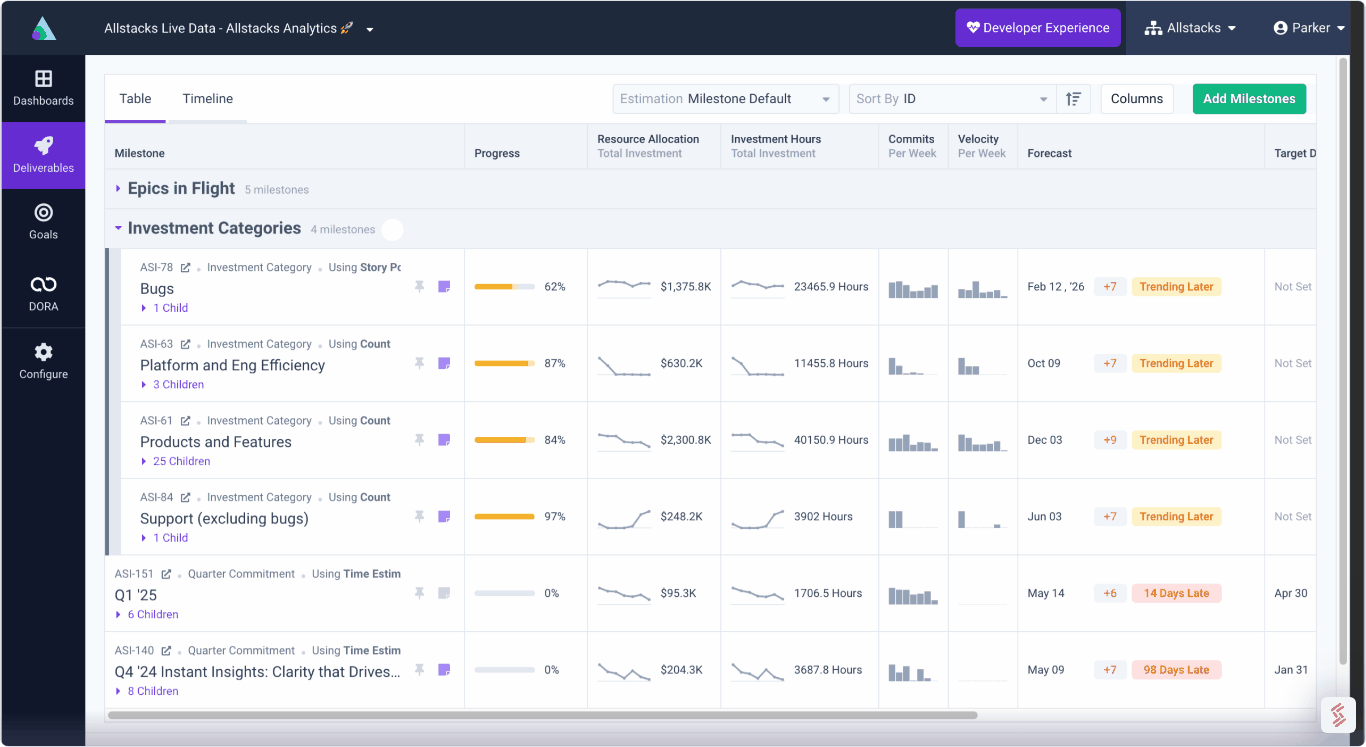.png)
Software Engineering Intelligence
-
Intelligence Engine
On-demand exhaustive AI-analysis
-
Engineering Investment
Complete visibility into time & dollars spent
-
360º Insights
Create meaningful reports and dashboards
-
Project Forecasting
Track and forecast all deliverables
DevEx
-
Developer Surveys
Create and share developer surveys
Software Capitalization
-
R&D Capitalization Reporting
Align and track development costs
The Metrics Maturity Trap: When Your Dashboard Becomes Your Biggest Enemy
I've been talking to VPs of Engineering all year, and there's this pattern nobody wants to admit: the most successful metrics programs eventually become outdated and in many cases their own worst enemy.

You know how this goes. You start tracking velocity because executives keep asking "how fast is engineering going?" Fair enough. Then you add DORA metrics because everyone says that's what mature teams do. Then cycle time, because deployment frequency doesn't tell the whole story. Then code quality metrics, because you need to prove you're not just moving fast but building sustainable systems.
Before you know it? You're drowning in dashboards, and your team spends more time explaining numbers than actually shipping software.
The Success Trap Nobody Sees Coming
Here's what blew my mind: the companies with the most sophisticated metrics programs are often the slowest at making decisions.
I was just talking to a VP at a Series C company who showed me their "metrics stack"—15 different dashboards, 47 KPIs, and a weekly metrics review meeting that runs 90 minutes. When I asked about their last major architectural decision, he said it took three months because they kept finding new angles to measure.
That's the trap. You build metrics to improve decision-making, but then the metrics become the decision-making process.
Three Warning Signs You've Gone Too Far
After seeing this play out dozens of times, there are three clear signals that you've moved from "needing more metrics" to "needing better decision-making":
Your team optimizes for the metric, not the outcome. I've watched engineering teams game their cycle time by artificially breaking down work, hit deployment targets by pushing cosmetic updates, and boost velocity by cherry-picking easier tasks. When your metrics start driving behavior instead of measuring it, you've crossed the line.
You have metrics reviewing your metrics. One director showed me their "metrics health dashboard"—literally a dashboard to track whether their other dashboards were working. If you need metrics to manage your metrics, you're in too deep.
Decisions get delayed waiting for "better data." The most telling sign: when leadership consistently delays decisions because they want "one more data point" or "to see next quarter's numbers." I've watched engineering teams miss competitive windows because they were still measuring whether they should act.
When Good Metrics Go Bad
Here's what the best VPs have taught me: certain metrics have expiration dates. Here are the ones that consistently turn toxic:
Individual developer productivity metrics become poison the moment your team figures out they're being measured. I've seen code review metrics turn collaborative feedback into checkbox exercises. Commit frequency tracking that makes developers batch unrelated changes. Story point velocity that rewards sandbagging estimates.
Process compliance metrics stop working once they become the process itself. One team was so focused on hitting their sprint commitment percentage that they stopped taking on uncertain work entirely. Their predictability went up, innovation went to zero.
Quality gate metrics become bottlenecks when they're disconnected from business impact. I worked with a team that had a 95% code coverage requirement blocking critical security patches because legacy modules couldn't hit the threshold.
The Retirement Decision Framework
So how do you know when to kill a metric? I use a simple framework that's worked across every engineering organization I've worked with:
The Last Action Test: When was the last time this metric directly influenced a decision? If you can't remember, or if the decision would have been the same without it, retire it.
The Gaming Check: Are people optimizing for this metric in ways that hurt the actual outcome? If yes, either fix the metric or kill it. Don't just accept the gaming.
The Urgency Filter: Does this metric help you act faster or slower? The best metrics compress decision-making time. If your metrics are adding analysis cycles instead of eliminating them, something's wrong.
Moving From Measurement to Intelligence
The engineering leaders who break out of this trap make a fundamental shift: they stop trying to measure everything and start focusing on predicting what matters.
- Instead of tracking 15 different productivity metrics, they focus on 3-5 leading indicators of delivery risk.
- Use Allstacks Investment Intelligence, instead of measuring individual developer performance. This will enable tracking team focus vs context switching and impacts on team capability and capacity.
- Instead of monitoring process compliance, they look at individual process slowdowns and breakdowns - where does the current workflow get bogged down.
This isn't about having fewer dashboards—it's about having smarter ones. The data is still there, but it's working in the background to surface insights instead of demanding constant attention.
What You're Really After
After talking to hundreds of engineering leaders, here's what we’ve learned: you don't really want more metrics. You want more transparency.
Transparency into whether your team is building the right things. Transparency into whether you're building things correctly. Transparency into whether everyone is aligned on what success looks like.
The metrics are just the means. When they become the end, you've lost sight of what you were trying to achieve in the first place.
But that transparency doesn't come from having perfect metrics. It comes from having the intelligence to act on imperfect information, quickly and confidently.
The most successful engineering leaders I know have learned to graduate from dashboard consumers to decision makers. The data informs them, but it doesn't define them.

